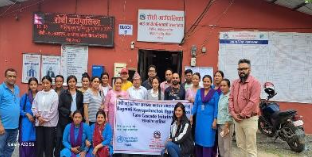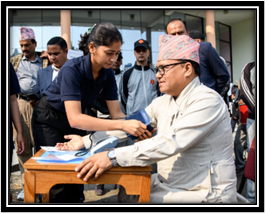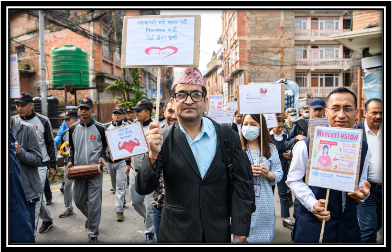
Bagmati Kavre Hypertension Care Cascade Initiative – A Model for People-Centered NCD Care Delivery
Hypertension is a critical public health concern in Nepal, affecting over one-fourth of the population. With approximately 4.7 million people suffering from the condition, only 400,000 individuals are receiving treatment, and just 200,000 have managed to control their blood pressure. This treatment gap increases the risk of serious health complications, including stroke, heart attack, and kidney disease. To address this growing issue, the Bagmati Kavre Hypertension Care Cascade Initiative (BKHCCI) was launched in 2023, with support from the World Health Organization (WHO) Country Office in Nepal. This initiative is aimed at reducing the treatment gap and improving the care cascade for hypertension, with Kavre district chosen as the demonstration site for people-centered non-communicable disease (NCD) care delivery.
Policy Milestone and Rollout
On February 17, 2023, the Ministry of Health and Population (MoHP), in collaboration with the WHO mission team, set an ambitious target: to enroll 1.5 million individuals living with hypertension or diabetes on treatment by 2025. This goal was established during a meeting chaired by Health Secretary Ministry of Health and attended by senior health officials. The strategy was clear – to accelerate coverage and control of hypertension through a primary healthcare approach. The meeting also led to the establishment of a national learning site in Kavre district, focusing on improving care coordination, referrals, protocol-based management, and tracking facility-based control rates.
WHO provided technical assistance, recruited an international consultant, and repurposed additional staff members to facilitate the necessary preparatory steps. This included adapting treatment protocols specific to drug dosages for hypertension and diabetes, developing facility registers, and creating tools for recording and reporting data. Stakeholder interactions were also conducted to ensure smooth implementation.
Key Events and Stakeholder Engagement
A series of critical events marked the rollout of the initiative. An expert consensus workshop led to the development of drug and dosage-specific treatment protocols for hypertension and diabetes. These protocols went beyond the existing WHO PEN protocols, ensuring primary healthcare providers had the tools they needed to deliver optimal care. Shortly thereafter, on May 17, 2023, the BKHCCI was officially inaugurated on World Hypertension Day at a ceremony in Dhulikhel, Kavre district. The event was attended by high-ranking officials, including the Director General of the Department of Health Services (DoHS), mayors, deputy mayors, and the Chief District Officer.
During the ceremony, Nepal’s national target of treating 1.5 million individuals for hypertension and diabetes by 2025 was announced. This commitment aligns with the WHO South-East Asia Regional Goal of ensuring 100 million people receive treatment for hypertension in the region by the same year. The joint pledge signed by various stakeholders, including 13 local government leaders, marked the beginning of the BKHCCI as a model for people-centered care.
Local Ownership and Capacity Building
One of the most significant strengths of the BKHCCI is its foundation of local ownership and mayor-led leadership. The program was co-created with the active participation of the Epidemiology and Disease Control Division (EDCD), Provincial Health Directorate, District Health Office, 13 municipalities, Dhulikhel Hospital, and WHO. This collaborative effort ensures the sustained supply of antihypertensive medications and the program’s long-term success.
The Kavre District Health Office, initiated a series of capacity-building sessions for healthcare workers across the district. These orientation sessions, were designed to ensure all health workers were adequately trained to deliver hypertension care. The municipalities took ownership of training the remaining healthcare workers using their own resources. Mayors participated in these sessions, emphasizing the local government’s commitment to integrating hypertension care into municipal health programs.
Monitoring and Progress
The initiative’s progress is regularly monitored through a robust system of supervision, clinical mentoring, and documentation. A critical collaboration was established with Dhulikhel Hospital, a tertiary care center in Kavre district, to provide clinical mentoring and supportive supervision to health facility teams.
By the end of 2023, the BKHCCI had achieved remarkable success. Within just three to four months of implementation, more than 5,000 individuals with hypertension were enrolled in the program, surpassing 33% of the annual enrollment target of 7,500. Additionally, patient follow-up rates exceeded 60%, a significant achievement in such a short time. However, several challenges were identified, including gaps in joint supervision, reliance on paper-based reporting systems, and healthcare worker workloads. These issues will need to be addressed to ensure the program's long-term sustainability.
Stocktake Workshop and Future Steps
In December 2023, a stocktake workshop was held, led by the Provincial Health Directorate and Kavre District Health Office, with participation from municipal health section chiefs, the Provincial Health Ministry, MoHP, Dhulikhel Hospital, and WHO. This workshop reviewed the early successes of the BKHCCI, identified bottlenecks, and charted the path forward. Health officers from neighboring districts attended the workshop to observe the implementation and consider replicating the model in their regions.
The workshop’s conclusion marked a turning point for the initiative. Additional Secretary of MoHP, reviewed the progress made and emphasized the importance of deepening the work within Kavre while gradually expanding the model to other districts. This incremental expansion is expected to establish the BKHCCI as a national pathfinder for NCD care delivery within Nepal's primary healthcare system.
Conclusion
The Bagmati Kavre Hypertension Care Cascade Initiative is a groundbreaking model for people-centered hypertension care in Nepal. It represents a united effort by local, provincial, and national stakeholders to tackle the silent epidemic of hypertension. With its focus on local ownership, sustainable supply chains, and evidence-based treatment protocols, the BKHCCI is prepared to make a significant impact on the health and well-being of thousands of Nepalese citizens. As it continues to evolve, the initiative holds the promise of transforming NCD care delivery across the country, providing a template for similar programs in other regions.


